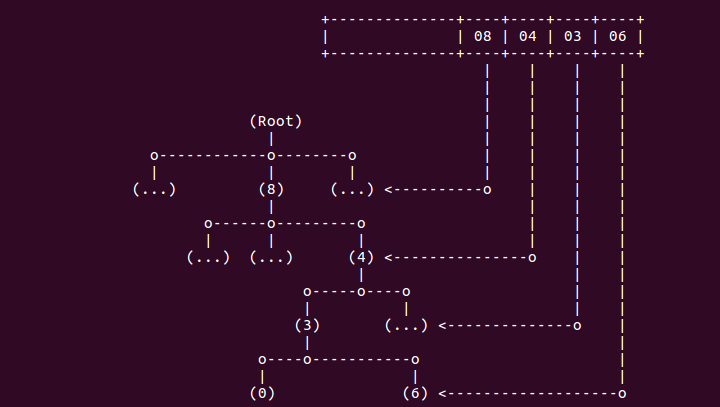
Email: BuddyZhang1 buddy.zhang@aliyun.com
目录

Radix-Tree 原理

Raix Tree 简介
Radix Tree 是一种压缩 trie,其中 trie 是一种通过保存关联数组 (associative array) 来提供关键字-值 (key-value) 存储与查找的数据结构。通常关键字是字符串,不过也可以是 其他数据类型。Radix Tree 是针对稀疏的长整型数据查找,能快速且节省空间地完成映射。 借助于 Radix Tree,可以实现对于长整型数据类型的路由。利用 Radix Tree 可以根据一个 长整型 (比如一个长 ID) 快速查找到其对应的对象指针, 这比用 hash 映射来的简单,也更 节省空间,使用 hash 映射 hash 函数难以设计,不恰当的 hash 函数可能增大冲突,或浪费 空间。
Radix tree 是一种多叉搜索树,树的叶子结点是实际的数据条目。每个结点有一个固定的、 2^n 指针指向子结点 (每个指针称为槽 slot,n 为划分的基的大小)
内核中的 Radix Tree
Linux 4.20 之前的内核使用 Radix Tree 管理很多内核基础数据结构,其中包括 IDR 机制。 但 Linux 4.20 之后,内核采用新的数据结构 xarray 代替了 Radix Tree。内核关于 Radix Tree 的源码位于:
include/linux/radix-tree.h
lib/radix-tree.c在 Linux 4.20 之前的内核中,Radix Tree 作为重要的基础数据,内核定义了一下数据结构 对 Radix Tree 进行维护。
struct radix_tree_node
/*
* @count is the count of every non-NULL element in the ->slots array
* whether that is an exceptional entry, a retry entry, a user pointer,
* a sibling entry or a pointer to the next level of the tree.
* @exceptional is the count of every element in ->slots which is
* either radix_tree_exceptional_entry() or is a sibling entry for an
* exceptional entry.
*/
struct radix_tree_node {
unsigned char shift; /* Bits remaining in each slot */
unsigned char offset; /* Slot offset in parent */
unsigned char count; /* Total entry count */
unsigned char exceptional; /* Exceptional entry count */
struct radix_tree_node *parent; /* Used when ascending tree */
struct radix_tree_root *root; /* The tree we belong to */
union {
struct list_head private_list; /* For tree user */
struct rcu_head rcu_head; /* Used when freeing node */
};
void __rcu *slots[RADIX_TREE_MAP_SIZE];
unsigned long tags[RADIX_TREE_MAX_TAGS][RADIX_TREE_TAG_LONGS];
};Linux 内核中,使用 struct radix_tree_node 数据结构定义了一个 radix-tree 的节点, 节点包含了多个成员,每个成员为构成 radix-tree 起到了关键作用。shift 成员用于指向 当前节点占用所有的偏移;offset 存储该节点在父节点的 slot 的偏移;参数 count 表示 当前节点有多少个 slot 已经被使用;exceptional 表示当前节点有多少个 exceptional 节点;参数 parent 指向父节点;参数 root 指向根节点;参数 slots 是数组,数组的成员 指向下一级的节点;参数 tags 用于标识当前节点包含了指定 tag 的节点数。
struct radix_tree_root
struct radix_tree_root {
spinlock_t xa_lock;
gfp_t gfp_mask;
struct radix_tree_node __rcu *rnode;
};Linux 内核中,使用 struct radix_tree_root 维护 radix-tree 的根节点。xa_lock 是一个自旋锁;参数 gfp_mask 用于标识 radix-tree 的属性以及 radix-tree 节点申请 内核的标识;参数 rnode 指向 radix-tree 的根节点。
struct radix_tree_iter
/**
* struct radix_tree_iter - radix tree iterator state
*
* @index: index of current slot
* @next_index: one beyond the last index for this chunk
* @tags: bit-mask for tag-iterating
* @node: node that contains current slot
* @shift: shift for the node that holds our slots
*
* This radix tree iterator works in terms of "chunks" of slots. A chunk is a
* subinterval of slots contained within one radix tree leaf node. It is
* described by a pointer to its first slot and a struct radix_tree_iter
* which holds the chunk's position in the tree and its size. For tagged
* iteration radix_tree_iter also holds the slots' bit-mask for one chosen
* radix tree tag.
*/
struct radix_tree_iter {
unsigned long index;
unsigned long next_index;
unsigned long tags;
struct radix_tree_node *node;
#ifdef CONFIG_RADIX_TREE_MULTIORDER
unsigned int shift;
#endif
};Linux 内核定义了 struct radix_tree_iter 结构用于遍历 radix-tree 中所有的 slots 时候,用于存储每次遍历到的节点。index 成员指明了被遍历到节点的索引值;成员 next_index 成员用于指明下一个节点的索引值;成员 tags 用于标识当前节点的 tag 属性; 成员 node 用于指明遍历到的节点。
Radix Tree 的架构原理
Linux 内核中,使用一个 struct radix_tree_root 结构作为根维护整棵 radix-tree。 每个节点采用 struct radix_tree_node 进行维护。在 radix-tree 中,节点被分作三 类,第一类称为 internal 内部节点,内部节点不存储任何私有数据,主要用于维护下一级 节点的 slots 数组;第二类称为 exceptional 节点,这类节点与 internal 类似, 专门维护 radix-tree 中的下一级 exceptional 节点;第三类就是一般节点,一般节点 的 slots 数组里面存储的就是私有数据,且不包含任何 internal 节点。
Radix-tree 在内核中用于将一个长整型数据与一个指针类型的数据相互对应,对应的原理 就是与长整型的特定字段作为 radix-tree 的特定节点的索引进行布局,因此形成了长整型 数据中多个字段作为 radix-tree 不同层 slots 的入口偏移,如下图:

如上图所示,存在一个长整型与一棵 radix-tree。linux 从长整型的左到右,依次按特定 长度的域作为 radix-tree 中每一层的索引。例如 radix-tree 的第一层采用了长整型最左边 域的值 8 作为索引,找到第一个 slots 入口,接着用 04 找到下一级 slots 入口,然后 03 再找到下一级的 slots,最后 06 找到最终 slot 的入口地址。通过这样的对应关系, 内核将长整型对应的私有数据存储在最终的 slot 里,这样就实现了一个长整型对应一个指针 的逻辑。
Radix-tree 的 tag 原理
Linux 内核中,radix-tree 的根节点使用 struct radix_tree_root 进行维护,其包含 了名为 gfp_mask 的成员,这个成员用于指明 radix-tree 的用途,该成员被拆分做多个 域进行使用,如下图:

ROOT tag 域用于指明 radixt-tree 的某些属性;GFP tag 域用于指明 radix-tree 在 向内存申请节点时使用的 GFP 标志;IDR tag 域用于指明 Radix tree 是否用于 IDR 机制。
在 struct radix_tree_node 里也存在 tag 成员,该成员是一个二维数组,该二维数组的 作用就是常说的用空间换时间的做法。在 radix-tree 查找特定的 slots 时候,将节点 tag 设置为不同的属性,例如在内核中,tag 经常被设置为 dirty 和 access,也就是 dirty tag 的时候,二维数组的第一位就是一个 BitMap,用于标记该 tag 下有多少 slot 被使用,内核 只需查找 bitmap 的使用情况,不必每个 slots 都进行查找,这将大大增加查找的速度。 具体请看 IDR 机制。struct radix_tree_node 的 tag 定义如下:
unsigned long tags[RADIX_TREE_MAX_TAGS][RADIX_TREE_TAG_LONGS];Radix-tree 一共支持 RADIX_TREE_MAX_TAGS 中 tag,每种 tag 包含了一个 Bitmap, 其长度为 RADIX_TREE_TAG_LONGS 个 unsigned long,每个 bit 代表一个 slots, 如果有 slot 被使用,那么该 Bitmap 对应的位就被置位;反之被清零。

Radix-tree 实践

Radix-tree 内核中最小实践
驱动源码
/*
* Radix tree.
*
* (C) 2019.06.01 <buddy.zhang@aliyun.com>
*
* This program is free software; you can redistribute it and/or modify
* it under the terms of the GNU General Public License version 2 as
* published by the Free Software Foundation.
*/
#include <linux/kernel.h>
#include <linux/init.h>
#include <linux/mm.h>
/* header of radix-tree */
#include <linux/radix-tree.h>
/*
* Radix-tree RADIX_TREE_MAP: 6
* (root)
* |
* o---------o---------o
* | |
* (0x0) (0x2)
* | |
* o-------o------o o---------o
* | | |
* (0x0) (0x2) (0x2)
* | | |
* o--------o------o | o--------o--------o
* | | | | | |
* (0x0) (0x1) (0x0) (0x0) (0x1) (0x3)
* A B C D E F
*
* A: 0x00000000
* B: 0x00000001
* C: 0x00000080
* D: 0x00080080
* E: 0x00080081
* F: 0x00080083
*/
/* node */
struct node {
char *name;
unsigned long id;
};
/* Radix-tree root */
static struct radix_tree_root BiscuitOS_root;
/* node */
static struct node node0 = { .name = "IDA", .id = 0x20000 };
static struct node node1 = { .name = "IDB", .id = 0x60000 };
static struct node node2 = { .name = "IDC", .id = 0x80000 };
static struct node node3 = { .name = "IDD", .id = 0x30000 };
static struct node node4 = { .name = "IDE", .id = 0x90000 };
static __init int radix_demo_init(void)
{
struct node *np;
/* Initialize Radix-tree root */
INIT_RADIX_TREE(&BiscuitOS_root, GFP_ATOMIC);
/* Insert node into Radix-tree */
radix_tree_insert(&BiscuitOS_root, node0.id, &node0);
radix_tree_insert(&BiscuitOS_root, node1.id, &node1);
radix_tree_insert(&BiscuitOS_root, node2.id, &node2);
radix_tree_insert(&BiscuitOS_root, node3.id, &node3);
radix_tree_insert(&BiscuitOS_root, node4.id, &node4);
/* search struct node by id */
np = radix_tree_lookup(&BiscuitOS_root, 0x60000);
BUG_ON(!np);
printk("Radix: %s id %#lx\n", np->name, np->id);
/* Delect a node from radix-tree */
radix_tree_delete(&BiscuitOS_root, np->id);
return 0;
}
device_initcall(radix_demo_init);驱动安装
驱动的安装很简单,首先将驱动放到 drivers/BiscuitOS/ 目录下,命名为 radix.c, 然后修改 Kconfig 文件,添加内容参考如下:
diff --git a/drivers/BiscuitOS/Kconfig b/drivers/BiscuitOS/Kconfig
index 4edc5a5..1a9abee 100644
--- a/drivers/BiscuitOS/Kconfig
+++ b/drivers/BiscuitOS/Kconfig
@@ -6,4 +6,14 @@ if BISCUITOS_DRV
config BISCUITOS_MISC
bool "BiscuitOS misc driver"
+config BISCUITOS_RADIX
+ bool "radix tree"
+
+if BISCUITOS_RADIX
+
+config DEBUG_BISCUITOS_RADIX
+ bool "radix tree mini"
+
+endif # BISCUITOS_RADIX
+
endif # BISCUITOS_DRV接着修改 Makefile,请参考如下修改:
diff --git a/drivers/BiscuitOS/Makefile b/drivers/BiscuitOS/Makefile
index 82004c9..9909149 100644
--- a/drivers/BiscuitOS/Makefile
+++ b/drivers/BiscuitOS/Makefile
@@ -1 +1,2 @@
obj-$(CONFIG_BISCUITOS_MISC) += BiscuitOS_drv.o
+obj-$(CONFIG_BISCUITOS_RADIX) += radix.o
--驱动配置
驱动配置请参考下面文章中关于驱动配置一节。在配置中,勾选如下选项,如下:
Device Driver--->
[*]BiscuitOS Driver--->
[*]radix tree
[*]radix tree mini具体过程请参考:
驱动编译
驱动编译也请参考下面文章关于驱动编译一节:
驱动运行
驱动的运行,请参考下面文章中关于驱动运行一节:
启动内核,并打印如下信息:
usbcore: registered new interface driver usbhid
usbhid: USB HID core driver
Radix-Tree: 0x20000
Radix-Tree: 0x30000
Radix-Tree: 0x60000
Radix-Tree: 0x80000
Radix-Tree: 0x90000
aaci-pl041 10004000.aaci: ARM AC'97 Interface PL041 rev0 at 0x10004000, irq 24
aaci-pl041 10004000.aaci: FIFO 512 entries
oprofile: using arm/armv7-ca9

Radix-tree 在应用程序中最小实践
实践源码
开发者也可以使用如下命令获得:
wget https://raw.githubusercontent.com/BiscuitOS/HardStack/master/Algorithem/tree/radix-tree/Basic/Makefile
wget https://raw.githubusercontent.com/BiscuitOS/HardStack/master/Algorithem/tree/radix-tree/Basic/README.md
wget https://raw.githubusercontent.com/BiscuitOS/HardStack/master/Algorithem/tree/radix-tree/Basic/radix_run.c
wget https://raw.githubusercontent.com/BiscuitOS/HardStack/master/Algorithem/tree/radix-tree/Basic/radix.c
wget https://raw.githubusercontent.com/BiscuitOS/HardStack/master/Algorithem/tree/radix-tree/Basic/radix.h实践源码具体内容如下:
/*
* Radix-Tree Manual.
*
* (C) 2019.05.27 <buddy.zhang@aliyun.com>
*
* This program is free software; you can redistribute it and/or modify
* it under the terms of the GNU General Public License version 2 as
* published by the Free Software Foundation.
*/
#include <stdio.h>
#include <stdlib.h>
/* radix-tree */
#include <radix.h>
/*
* Radix-tree RADIX_TREE_MAP: 6
* (root)
* |
* o---------o---------o
* | |
* (0x0) (0x2)
* | |
* o-------o------o o---------o
* | | |
* (0x0) (0x2) (0x2)
* | | |
* o--------o------o | o--------o--------o
* | | | | | |
* (0x0) (0x1) (0x0) (0x0) (0x1) (0x3)
* A B C D E F
*
* A: 0x00000000
* B: 0x00000001
* C: 0x00000080
* D: 0x00080080
* E: 0x00080081
* F: 0x00080083
*
*/
/* node */
struct node {
char *name;
unsigned long id;
};
/* Radix-tree root */
static struct radix_tree_root BiscuitOS_root;
/* Range: [0x00000000, 0x00000040] */
static struct node node0 = { .name = "IDA", .id = 0x21 };
/* Range: [0x00000040, 0x00001000] */
static struct node node1 = { .name = "IDB", .id = 0x876 };
/* Range: [0x00001000, 0x00040000] */
static struct node node2 = { .name = "IDC", .id = 0x321FE };
/* Range: [0x00040000, 0x01000000] */
static struct node node3 = { .name = "IDD", .id = 0x987654 };
/* Range: [0x01000000, 0x40000000] */
static struct node node4 = { .name = "IDE", .id = 0x321FEDCA };
int main()
{
struct node *np;
struct radix_tree_iter iter;
void **slot;
/* Initialize Radix-tree root */
INIT_RADIX_TREE(&BiscuitOS_root, GFP_ATOMIC);
/* Insert node into Radix-tree */
radix_tree_insert(&BiscuitOS_root, node0.id, &node0);
radix_tree_insert(&BiscuitOS_root, node1.id, &node1);
radix_tree_insert(&BiscuitOS_root, node2.id, &node2);
radix_tree_insert(&BiscuitOS_root, node3.id, &node3);
radix_tree_insert(&BiscuitOS_root, node4.id, &node4);
/* Iterate over Radix-tree */
radix_tree_for_each_slot(slot, &BiscuitOS_root, &iter, 0)
printf("Index: %#lx\n", iter.index);
/* search struct node by id */
np = radix_tree_lookup(&BiscuitOS_root, 0x321FE);
BUG_ON(!np);
printf("Radix: %s ID: %lx\n", np->name, np->id);
/* Delete a node from radix-tree */
radix_tree_delete(&BiscuitOS_root, node0.id);
radix_tree_delete(&BiscuitOS_root, node1.id);
radix_tree_delete(&BiscuitOS_root, node2.id);
return 0;
}源码编译
使用如下命令进行编译:
make clean
make源码运行
实践源码的运行很简单,可以使用如下命令,并且运行结果如下:
radix-tree/Basic$ ./radix
Index: 0x21
Index: 0x876
Index: 0x321fe
Index: 0x987654
Index: 0x321fedca
Radix: IDC ID: 321fe
Radix-Tree 在内核中的应用
Radix-Tree 插入操作
Radix-tree 提供了一套完整的插入机制,内核通过 index 索引值进行插入。根据 radix-tree 的原理,内核插入 index 到 radix-tree 之后,内核首先判断当前 radix-tree 是否能够存储 index,如果能,那么继续插入;如果不能,那么内核就 增加 radix-tree 树的高度,树的高度一增加,原始的节点的深度也增加,原始的根 节点变成了新根节点的 slot[0] 的孩子。内核在确保 radix-tree 可以存储 index 之后,就将 index 的域从中将特定位置开始,从左到右以此作为索引在 radix-tree 中查找 slots,如下图:

如上图所示,存在一个长整型与一棵 radix-tree。linux 从长整型的左到右,依次按特定 长度的域作为 radix-tree 中每一层的索引。例如 radix-tree 的第一层采用了长整型最左边 域的值 8 作为索引,找到第一个 slots 入口,接着用 04 找到下一级 slots 入口,然后 03 再找到下一级的 slots,最后 06 找到最终 slot 的入口地址。通过这样的对应关系, 内核将长整型对应的私有数据存储在最终的 slot 里,这样就实现了一个长整型对应一个指针 的逻辑。
内核提供了插入相关的接口函数,开发者可以参考下面的文章进行对应的实践:
Radix-Tree 查询操作
Linux 提供了相应的接口用于在 radix-tree 中查找符合条件的节点,节点的 slot 存储 着对应的私有数据。Radix-tree 的查找很将当,就是通过 index 进行查找,radix-tree 将 index 拆分成多个索引,从根节点开始,在每一层节点的 slots 数组里找到指定的 入口地址,然后进入下一层继续查找,知道找到最后一个 slot,如果找到,那么就返回 私有数据;如果没有找到,则返回对应的错误码。如下图:

Linux 内核为了加快在 radix-tree 中的查找,采用了一种称为空间换时间的做法, 在 radix-tree 查找特定的 slots 时候,将节点 tag 设置为不同的属性,例如在内核中,tag 经常被设置为 dirty 和 access,也就是 dirty tag 的时候,二维数组的第一位就是一个 BitMap,用于标记该 tag 下有多少 slot 被使用,内核 只需查找 bitmap 的使用情况,不必每个 slots 都进行查找,这将大大增加查找的速度。 具体请看 IDR 机制。struct radix_tree_node 的 tag 定义如下:
unsigned long tags[RADIX_TREE_MAX_TAGS][RADIX_TREE_TAG_LONGS];Radix-tree 一共支持 RADIX_TREE_MAX_TAGS 中 tag,每种 tag 包含了一个 Bitmap, 其长度为 RADIX_TREE_TAG_LONGS 个 unsigned long,每个 bit 代表一个 slots, 如果有 slot 被使用,那么该 Bitmap 对应的位就被置位;反之被清零。基于这种机制, 内核能在 radix-tree 中快速找到所需的节点。
内核提供了查找相关的接口函数,开发者可以通过下面文章进行相关实践:
Radix-Tree 修改操作
Linux 内核中,对 radix-tree 的修改操作指的是修改 index 对应的指针私有数据。 由 radix-tree 的原理可以知道,index 在 radix-tree 中对应 slot 中存储私有指针, 因此修改操作就是修改特定的私有指针值。
Linux 内核在以下两种情况下会触发修改操作,一是主动修改私有指针,二是删除操作时 也会修改。修改的逻辑是通过查找操作找到 index 对应的私有指针,然后修改节点对应 slot 的值即可,开发者可以参考如下文章进行相应的实践:
Radix-Tree 删除操作
Linux 内核也提供了 radix-tree 的删除操作。删除一个节点的基本思路是:通过 index 找到对应的节点,然后将其父节点的 slots 入口设置为 NULL,如果删除的节点是一个内部 节点,且该节点没有任何的孩子,那么 radix-tree 就是进行 shrink 操作,减小树的高度。 开发者可以通过下面的文章进行详细了解和实践:
Radix-Tree 遍历操作
内核也提供了一套接口用于遍历 radix-tree 树上的所有 slot。内核定义了一个 struct radix_tree_iter 数据结构用于存储每次遍历的数据,每次遍历到一个 slot之后, 都会将必要的信息存储在 struct radix_tree_iter 内,以便便捷使用。开发者 可以参考如下文章进行实践:

Radix-Tree 内核接口函数列表
附录
赞赏一下吧 🙂
